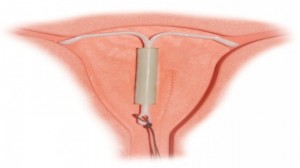Definition of "Intrauterine device"
Last modified: 1 day
It's a device you put inside the uterus, hence the name. Uterus just means a woman's womb.
So it's a contraceptive, meaning it prevents pregnancy. What makes it different is that it can be used in the long term. When we say long we mean loooong, like up to 7 years for the Mirena.
There's the risk of pain when you put it in. So there's the risk of it popping out of the womb. It can cause the womb to have a hole. There's a small risk of it not working, and when it doesn't, it's an ectopic pregnancy. It can alter bleeding, so the hormonal type reduces or even stops bleeding, but the copper ones can actually INCREASE this. Risk of infection.
Intrauterine devices (IUD's, aka coil) are small devices, often T-shaped, containing either copper or levonorgestrel, inserted into the uterus.
Examples include IUD with progestogen (Mirena), and IUD with copper.

Source: 2013/04/rsz_mirena-iud-938x1024-300x168.jpg">Drug dangers
Patient information
What is an intrauterine device?It's a device you put inside the uterus, hence the name. Uterus just means a woman's womb.
Purpose
- It provides long-acting reversible contraception, with the Mirena approved to be used up to 5 years but studies showing it is effective up to 7 years
- Once removed, even after long use, fertility returns to normal IMMEDIATELY
- It is effective and safe to use in adolescents, and those who have and have not had children previously
- It doesn't affect breastfeeding, and can be inserted immediately after delivery
- It can be used immediately after an abortion
Patient information
Why would you want to put a device inside the womb?So it's a contraceptive, meaning it prevents pregnancy. What makes it different is that it can be used in the long term. When we say long we mean loooong, like up to 7 years for the Mirena.
So if I want to get preggers, if I take it out, how long before I return to normal?
Immediately.
How about when breastfeeding?
Yep, you can use it.
Abortion?
Immediately after.
Risks
- Substantial pain, for women undergoing IUD insertion, that requires active Mx, in 17% of nulli's, and 11% of parous women. NSAID's are effective for this
- Expulsion (2.3%)
- Uterine perforation (<0.7%)
- Pelvic inflammatory disease, especially in the 1st 21 days after insertion
- Small risk of pregnancy, with failure rates with copper IUD is 0.8%, and with levonorgestrel IUD is 0.2%
- When there is pregnancy, it is more likely to be an ectopic pregnancy
- Irregular menstrual pattern, including:
- Copper IUD's may increase menstrual bleeding and result in more painful cramps. Cramping can be Tx with NSAID's
- Hormonal IUD's may reduce or even stop menstrual bleeding altogether
- Specific to IUD's with progesterone:
Patient information
OK. That's a lot of plusses for this device in the womb which stops you from getting preggers. What are the risks?There's the risk of pain when you put it in. So there's the risk of it popping out of the womb. It can cause the womb to have a hole. There's a small risk of it not working, and when it doesn't, it's an ectopic pregnancy. It can alter bleeding, so the hormonal type reduces or even stops bleeding, but the copper ones can actually INCREASE this. Risk of infection.
Epidemiology
- Most widely used form of reversible contraception, with more than 180m users worldwide
See also
- Birth control (category)
Synonyms:
Coil
Copper containing IUD
Copper IUD
Expulsion
IUD
IUD copper
IUD progestogen
IUD with copper
IUD with progestogen
Mirena
Mirena IUD
Postcoital IUD
Progesterone IUD
Progesterone releasing IUD
Progestogen IUD
Find a practitioner
Practitioner count: 0
Sponsor a disease. And see how your proceeds help.
$1
Express interest
$10
Write text
$40
Write FAQ
$100
Snap photos
$400
Record audio
$1k
Produce video
$4k
Interview experts